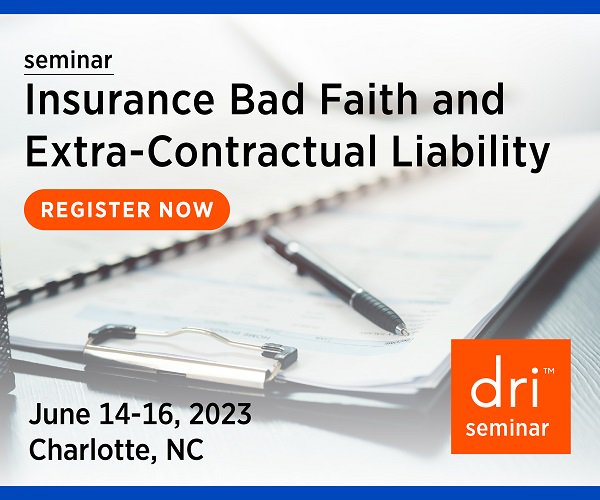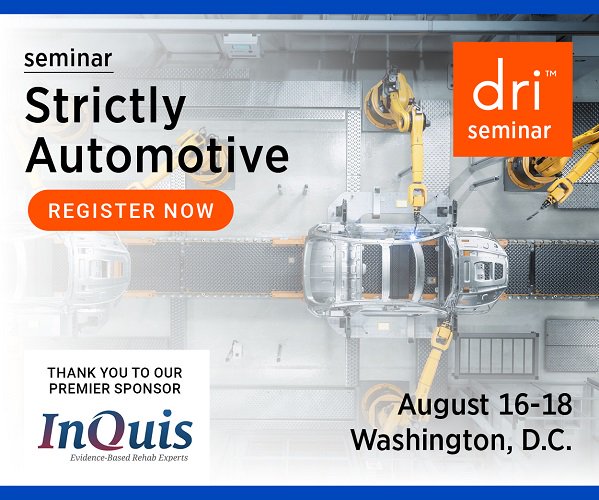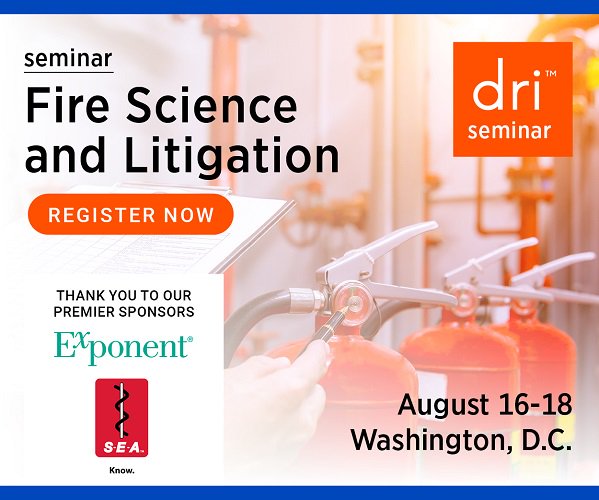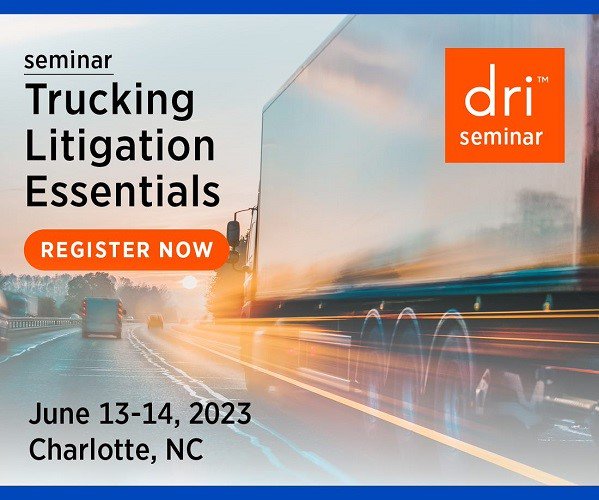Insurance Law: Covered Events
Leadership Note: Insurance Law SLG
By Michael B. Gelfound
I became a member of DRI earlier this year and made my inaugural appearance at the Insurance Coverage and Claim Institute (ICCI) in Chicago, Illinois. The conference covered key topics that insurance companies and attorneys regularly face in the industry and had excellent speakers that captivated the audience. The information and practical advice provided at that conference has already helped me in my practice.
In addition to the valuable lessons obtained from the seminars, DRI has provided me with the opportunity to network with top-notch professionals in the insurance industry and to make new friends and colleagues. After hearing many testimonials from long-time DRI members, I immediately had an interest in joining the Insurance Law Committee and to volunteer my time to contribute to this great organization.
I am looking forward to upcoming events and to work with DRI members to provide great content for its members and those potentially interested in joining.
 Michael B. Gelfound is a Partner in Freeman Mathis & Gary, LLP’s Los Angeles office. He has an array of insurance coverage experience and is skillful in resolving complex insurance coverage disputes, which includes resolution in state and federal courts, arbitration, and mediation. He has been selected as Best Lawyers: Ones to Watch in America, Appellate Practice in 2023 as well as Super Lawyers Southern California Rising Stars from 2020-2023. He is a member of the Insurance Law Committee and is an assistant editor for DRI’s publications.
Michael B. Gelfound is a Partner in Freeman Mathis & Gary, LLP’s Los Angeles office. He has an array of insurance coverage experience and is skillful in resolving complex insurance coverage disputes, which includes resolution in state and federal courts, arbitration, and mediation. He has been selected as Best Lawyers: Ones to Watch in America, Appellate Practice in 2023 as well as Super Lawyers Southern California Rising Stars from 2020-2023. He is a member of the Insurance Law Committee and is an assistant editor for DRI’s publications.
How Equipment Loss Consulting Can Produce Indemnity Savings
By Nicholas Jannetto - Practice Leader - Equipment Loss Consulting at Envista Forensics
In a recent claim investigation, a large printing press motor shorted out, causing sparks and overheating of paper bales, which, in turn, created smoke and soot damage on the surrounding equipment and numerous areas throughout the property. In total, the damage extended to more than 300 pieces of equipment and created over $10M of potential exposure.
In situations like this, it is critical to act swiftly yet thoroughly to mitigate further damages from occurring. It is important for all parties involved to understand how these items are catalogued and the proper methods to mitigate, identify what can be restored, repaired and/or replaced, and who can provide a viable scope and cost analysis.
Whether a catastrophic incident affects equipment, or it undergoes a failure of some kind, an equipment loss consultant can help sift through the complexities. In this case, wipe samples were taken on the equipment and a team of consultants, engineers, and technicians determined which items could be restored, repaired and/or replaced, saving the insured over $10M and months of business interruption.
Engaging equipment experts upfront can save both time and money, but beyond that these experts can help determine causation and subrogation potential. They can provide expert testimony, help find viable repair, restoration, replacement and salvage options, decipher code requirements versus betterments, identify alternative processes or solutions, and even help preserve the scene and collect evidence.
Choosing the Right Expert
Equipment Consultants have a variety of backgrounds and experiences in mechanical, electrical, fire suppression, building and structural engineering. Choosing the right expert can help exponentially, moving the claim forward while saving more than just time and money. Mechanical, electrical, plumbing, structural and building repairs, including fire and water damage to specialized equipment, are but a few outlets of opportunities for an expert to add value and lead the way.
MEP Building Repairs
Mechanical, Electrical and Plumbing (MEP) systems are the backbone that makes buildings habitable for humans. These three technical fields are designed together as the foundation of a safe building environment. This is where engaging an expert upfront can help sift through the unknown and help rule out potential causes while identifying the facts. For example, correctly identifying heat damage directly from a fire event and additional exposure from soot and smoke including water from the fire extinguishment can make a scene very complex and challenging. Instead of tear down and re-construction, experts can work together with contractors, building inspectors and OEMs to identify the electrical, mechanical and plumbing systems to be professionally decontaminated, repaired and/or replaced, which can save on scope of repairs, replacement equipment and business interruption.
Water Damage to Specialized Equipment
Equipment losses can be intricate and if they are not assessed quickly and thoroughly, they can put an organization's production and future at risk. These kinds of losses can present several challenges, which is where Equipment Loss Consultants come in. Equipment Consultants can confirm direct water exposure and penetration including signs of rust and corrosion. However, in some cases equipment may show no signs of direct water exposure and can be restored and/or decontaminated as a precautionary measure avoiding full replacement, reconfiguring of processes, additional training, startup, and commissioning. Experts utilize scientific methodologies and collect samples, such as wipe samples, to determine the levels of contaminants related to the claimed peril or from normal operating conditions.
Structural Building Modifications and Code Upgrades
Building systems consist of processes or systems that are critical to upholding successful operations of a structure and if any of these systems are damaged it can compromise a building's performance and safety. For example, a building’s fire suppression system main control panel might need code upgrades and/or replacement as a result of a localized fire event even though the remote devices remain unaffected. Conversely, if the remote devices have been directly affected by a localized fire event, yet the central control panel remain unaffected by the peril, it may not need upgrades/replacement depending on the local codes and authority having jurisdiction.
Equipment Consultants can help assess damages to the electrical and mechanical subsystems, perform additional testing in conjunction with certified Original Equipment Manufacturer (OEM) technicians, and confirm peril-related damages. These measures are taken to verify the peril-related scope of repairs and claimed replacements. For example, unwarranted additional structural modifications and building code upgrades as a result of replacement equipment capacities and physical footprints may require a larger area and support.
Equipment Loss Consultants Can Save More Than Just Time and Money
Engaging experts upfront can help in a variety of different ways to identify extent of damage, determine viable restoration, repair and replacement options, reducing business interruption. They help support subrogation potential in ruling out and/or determine causation, providing expert testimony, and preserving both the scene and equipment. Experts can address pre-existing warranty options and provide salvage potential while verifying cost estimates and equipment capacities. Furthermore, Equipment Loss Consultants can determine required code upgrades as it relates to the claimed peril versus owner improvements, simultaneously resourcing alternative supply-chain and business solutions. Equipment Loss Consulting is more than just a pricing exercise, it is the key to navigating complex claims with comprehensive solutions.
 Mr. Jannetto is the Practice Leader of the Equipment Loss Consulting Group at Envista Forensics located in Orange County, California. Nick leads the practice in providing failure analysis, equipment causation, damage valuations, and technical solutions following losses to specialized electrical and mechanical equipment and building systems. He authors reports and supporting documentation for clients in engineering, legal, and business communities alike. He also conducts experimental research to identify failure modes of electrical and mechanical equipment.
Mr. Jannetto is the Practice Leader of the Equipment Loss Consulting Group at Envista Forensics located in Orange County, California. Nick leads the practice in providing failure analysis, equipment causation, damage valuations, and technical solutions following losses to specialized electrical and mechanical equipment and building systems. He authors reports and supporting documentation for clients in engineering, legal, and business communities alike. He also conducts experimental research to identify failure modes of electrical and mechanical equipment.
Interested in joining the Insurance Law Committee? Click here for more information.
Print this section
Print the newsletter
Product Liability: An Update from the PLC
New Theories of Product Liability Develop in the Age of Artificial Intelligence and Increased Automation
By Devin R. Bates and Benjamin D. Jackson
In recent years, products liability law has been significantly impacted by advancements in technology, particularly with the rise of artificial intelligence (AI) and automation. As more companies adopt these technologies to improve their manufacturing processes and product design, new theories of products liability will emerge. In this blog post, we will explore some new theories of product liability claims that are emerging.
Traditionally, products liability claims have focused on the manufacturer’s failure to warn consumers of a product’s potential dangers or defects, failure to recall or correct a known safety issue, or other more traditional and tangible alleged harm. However, with the increased reliance on AI, the focus of some litigation will shift to the manufacturer’s failure to adequately design and test their products to account for the risks and unintended consequences that can arise from these technologies. Some of these newly emerging theories include:
Cybersecurity Defects: With the rise of the Internet of Things (IoT), products are becoming increasingly connected and reliant on software. This creates new opportunities for product liability claims based on uncontrolled cybersecurity threats and defects. If a product is designed with allegedly inadequate cybersecurity protections, it could be vulnerable to hacking, which could result in consumer injury or loss. For example, a hacker could take control of a self-driving car or medical device, causing a serious accident or injury. As a result, the plaintiff’s bar will be looking for test cases to hold manufacturers liable for “cybersecurity defects” in their products.
Failure to Warn of Privacy Risks: Another emerging area of product liability law is the alleged failure to warn of privacy risks. As more products collect and store personal data, there is a risk of that data being stolen or misused. If a manufacturer fails to adequately warn consumers of these risks, the plaintiff’s bar will advance cases on the theory that a manufacturer should be held liable for any resulting harm. For example, if a fitness tracker collects personal health data that is then stolen by hackers, a plaintiff may later attempt to argue that the manufacturer could be held responsible for failing to warn consumers of the risk of data theft.
Design Defects Caused by Artificial Intelligence: As more products rely on AI and machine learning, there is a risk that these technologies could introduce design defects. For example, an AI system used to control a vehicle could malfunction and cause an accident. If the design of the AI system is found to be defective, a plaintiff will inevitably bring a claim against the manufacturer for the resulting injuries or damages. Products claims alleging AI defects will be intensely technically and complex, sorting through layers of design, testing, and manufacturing.
Liability for Third-Party Add-Ons: Manufacturers are already very mindful of liability injected into the equation through third-party add-ons to their products. For example, if a consumer installs a Bluetooth enabled aftermarket part on their car that causes a malfunction, that consumer may attempt to allege that the car manufacturer should still be held liable for any resulting injuries or damages. A pioneering plaintiff will inevitably argue that this theory of liability recognizes that manufacturers have a duty to design their products to be safe even when used with third-party add-ons. Of course, on the defense side, this type of case would provide many opportunities for testing the boundaries of comparative fault.
Failure to Monitor Social Media for Product Issues: Finally, with many manufacturers employing the services of social media managers either in-house or through contractors, it is only a matter of time before a plaintiff’s lawyer will argue that manufacturers should be held liable for failing to monitor social media for product issues. If consumers are reporting problems with a product on social media, it may later be alleged that the manufacturer had a duty to investigate and address those issues. This theory of liability recognizes the importance of social media as a source of information about product defects and the need for manufacturers to comprehensively monitor social media for more than just public relations concerns.
In conclusion, as products become more complex and interconnected, new theories of product liability litigation are emerging. While technology continues to evolve and products cases lag several steps behind, savvy products lawyers will need to stay abreast of new technologies and the complex new theories of cases that come with them.
 Ben Jackson is a partner at Mitchell, Williams, Selig, Gates & Woodyard, P.L.L.C. As a litigator and trial attorney, he defends corporations, institutional clients and insurance companies in catastrophic personal injury and death cases, primarily including products liability, toxic tort and medical injury. He has worked as lead trial counsel on numerous catastrophic injury cases and regularly serves as local counsel assisting out-of-state defense attorneys in Arkansas litigation. Ben is recognized as one of JD Supra Readers' Choice Top Authors in Products Liability.
Ben Jackson is a partner at Mitchell, Williams, Selig, Gates & Woodyard, P.L.L.C. As a litigator and trial attorney, he defends corporations, institutional clients and insurance companies in catastrophic personal injury and death cases, primarily including products liability, toxic tort and medical injury. He has worked as lead trial counsel on numerous catastrophic injury cases and regularly serves as local counsel assisting out-of-state defense attorneys in Arkansas litigation. Ben is recognized as one of JD Supra Readers' Choice Top Authors in Products Liability.
 Devin Bates is a partner at Mitchell, Williams, Selig, Gates & Woodyard, P.L.L.C. He is a trial attorney defending clients in complex litigation related to products liability, employment issues, non-compete litigation, intellectual property, trade secret disputes and claims of fraud. Devin is recognized as one of JD Supra Readers' Choice Top Authors in Products Liability.
Devin Bates is a partner at Mitchell, Williams, Selig, Gates & Woodyard, P.L.L.C. He is a trial attorney defending clients in complex litigation related to products liability, employment issues, non-compete litigation, intellectual property, trade secret disputes and claims of fraud. Devin is recognized as one of JD Supra Readers' Choice Top Authors in Products Liability.
Interested in joining the Product Liability Committee? Click here for more information.
Young Lawyers: Raising the Bar
Pre-Discovery Deposition Investigations Pay Dividends
By Michael E. Tuttle, Esq., and Jessica E. Keeler, Esq.
The Plaintiff’s discovery deposition will be the first opportunity for the Defense to assess the Plaintiff’s demeanor and candor and develop a sense of how the Plaintiff will play to a jury. The Defense ought to evaluate the merits of the allegations, the credibility of the Plaintiff testimony, as well as the potential counterfactuals that will advance the defense.
While the veracity of a sworn witness is expected, Plaintiff’s counsel has surely advised their client on the weakness of the allegations and the soft spots in the in the governing law – all that to say, Plaintiff’s counsel has not limited their instructions to simply, “tell the truth.” Moreover, Plaintiff’s counsel has certainly rehearsed critical segments of the allegations, including: (i) the lead up to the incident; (ii) the incident, in detail; (iii) the injuries and treatment; and (iv) the “before vs. after,” or lifestyle changes, physical limitations, and general damages. In toxic tort claims, the “before” is typically inclusive of a latency period that can span decades – which is the time period of the investigation into potential alternative exposures.
Local Newspapers: All the Hyper-Local News That’s Fit to Print
Perusing historical editions of the Plaintiff’s hometown newspaper is not only sure to be amusing, but this type of investigation often leads to potential sources of alternative exposure that may have contributed to Plaintiff’s disease. Local gazettes memorialize events which were significant in a hyper-local forum, namely where the Plaintiff resided or where the Plaintiff worked. Articles referring to OSHA fines at a nearby factory, an asbestos abatement project at a public school, a town counsel’s fury over dirty public drinking water, or the demolition of a longstanding landmark or historical building, can be the basis of a line of questioning of the Plaintiff. The Plaintiff will very likely be familiar with these significant, albeit hyper-local, events and may have some meaningful exposure to them. Importantly though, if Defense counsel is not already aware of such local events, it is not in the Plaintiff’s interest to mention them and develop their own potential alternative exposures.
Publicly Available Records: A Targeted Approach
Typically, prior to the Plaintiff’s discovery deposition, Plaintiff will have produced certain discovery materials, which may include responses to interrogatories, medical records, employment records, military service records, and social security records. There is critical geographical information strewn throughout many of these records which can be used develop the Plaintiff’s residential history, employment history, educational history, etc. A tidy chart of where the Plaintiff was and when, radically increases the likelihood of a successful search of publicly available records that may develop the Plaintiff’s potential alternative exposures. As a poignant example, Plaintiff’s discovery production disclosed her employment as a thespian at a specific theatre; a targeted request for access to publicly available records pertaining to that theatre revealed that years after Plaintiff’s employment, the playhouse filed a statutorily required asbestos abatement notice to remove the asbestos-containing stage backdrop curtain. While an asbestos-containing stage backdrop curtain may not present in many cases, public schools and houses of worship are commonplace to nearly every Plaintiff. Furthermore, public schools and houses of worship tend to operate in longstanding buildings which are replete with a trove of publicly available records and make for an excellent starting point in a targeted approach to accessing publicly available records.
Public Benefits: It Is in the Details
In certain jurisdictions, the Plaintiff may be compelled to disclose their receipt of renumerations, payments, or benefits related to their claims of certain qualifying disease or injury. To put a finer point on it, there are dozens of Asbestos Personal Injury Trusts, there is the 9/11 Compensation Fund, state Workers’ Compensation judgments, and in the United Kingdom, the Department for Work and Pensions dispenses numerous benefits to Plaintiff’s who are British nationals. As one would image, Plaintiff’s tend characterize their diseases and injuries in a light that is most favorable to their claim being awarded; any many times, Plaintiff’s claims for payments and benefits may not entirely align with their allegations of a toxic tort claim. It is often the case that when Plaintiff seeking this type of renumeration, the offer specific details of their actual alternative exposures, including information about worksites, locations, employers, co-workers, materials, and product tradenames.
Medical Records: Read Between the Lines for the Dicta
The review of a Plaintiff’s medical records is not only critical to determine a timeline of significant events – the diagnosis, the initial onset of symptoms of the alleged disease or injury, the course of treatment, and the prognosis – a close review of the medical records will, often times, reveal facts and information that will guide your investigation into the potential alternative exposures that may have contributed to the Plaintiff’s diagnosis.
In medical malpractice claims, specifically, it is vital to thoroughly review pre-injury medical records, medical records related to the incident, and, if applicable, post-injury medical records. Review of pre-injury medical records may lead you to discover potential pre-existing genetic or medical conditions that may have caused or contributed to the Plaintiff’s injury. Post-injury medical records will guide your deposition question outline as to what activities of daily living or other general hobbies the Plaintiff can allegedly no longer do. It is imperative to get a complete picture of the damages the Plaintiff may claim at trial so as to fully prepare arguments against the eventual claim for pain and suffering.
Fact Witnesses. For example, it is not unusual for a Plaintiff suffering from malignant cancer to be accompanied by a non-party individual to a medical consultation, which may be noted in the narrative of a medical record. When a Plaintiff’s memory fails to recall whether a treating physician offered a causation opinion – “it was your work pipe insulation during your Navy service that caused your mesothelioma” – or an exonerating opinion – “it was your 30-year smoking history that caused your lung cancer” – these non-party individuals may be called to testify about what they may have heard during that medical consultation. Furthermore, in certain circumstances, Defendants may seek to develop forum non conveniens defenses and identifying non-party witnesses who are outside of the reach of the Court’s jurisdiction will surely advance such a defense.
Causation. In toxic tort claims, the Plaintiff alleges that exposure to a toxin was a substantial contributing factor to the development of their disease and the cause of their injuries. Occasionally, but especially in a case with a Plaintiff alleging a so-called signal disease, a physician may document details about the Plaintiff’s occupational or personal exposure to the suspected toxin. This information may shed light on the sources and timeframe of exposures, the type of exposure (i.e. bystander, environmental, occupational, take-home), locations of these exposures, and may even include the identification of a suspected product. In a recent matter, burred at page 608 of Plaintiff’s discovery production included a note from Plaintiff’s oncologist, “her father worked for [ ] Nuclear Fuels and was a boiler man. He used to bring his work clothes home and this would have included most of the 1970’s.” Ostensibly, this narrative is devoid of any medical opinion, but this type of dicta can be a wellspring of crucial information to help fully develop the Plaintiff’s potential alternative exposures.
Social Media: A Picture Is Worth a Thousand Words
Many states have broad discovery rules which allow for at least a portion of a Plaintiff’s social media account. For instance, in Florida, sections 1.280(b)(1) and 1.350(a) of the Florida Rules of Civil Procedure permit the discovery of electronically stored non-privileged material, which includes social media content. Photos, videos, comments, etc. on Plaintiff’s social media posts can depict the Plaintiff’s activities of daily living which are extremely relevant to personal injury claims. Doing a “deep dive” on Plaintiff’s social media accounts can assist in developing your litigation strategy and provide insights such as potential case witnesses, information that refutes a Plaintiff’s claims, and even ulterior motives for Plaintiff’s claims.
Prior Court Actions and Bankruptcy Filings
Investigations into prior lawsuits can be informative and may give you a potential basis to claim the Plaintiff is biased in bringing the claim. An extremely litigious Plaintiff may have brought so many numerous claims before this litigation that it would inform you that they are just after a quick payday. Perhaps the Plaintiff has a recent or even pending Bankruptcy proceeding that may fuel the current lawsuit. Even if this information is not utilized in your deposition questions, it can certainly inform you of the proper approach, tone, and strategy to take.
Criminal History: Not Just Impeachment
The review of a Plaintiff’s or fact witness’s criminal history can provide for impeachment material that, depending on the jurisdiction and circumstances, may be used at trial. In general, discovery of such information is usually limited to those felonies or crimes of dishonesty that occurred within the past ten (10) years. However, if the witness has a conviction for a felony or crime of dishonesty, that may be used at a trial. In addition to standard impeachment, however, some prior criminal history could be relevant to the present litigation. For instance, if the Plaintiff is claiming a brain injury that is causing personality changes such as aggression, some prior criminal history showing pre-injury aggressiveness may be relevant depending on the jurisdiction. A close review of the criminal history of the witness can guide your questioning and uncover a potential alternative cause to Plaintiff’s diagnosis or injury.
Conclusion
Depositions are essential for many reasons in litigation, not least of which is identifying key information for your case and crafting your case for trial. Thorough preparation and investigation into the witness prior to the deposition is key for being able to fully identify, understand, and elaborate on the various key issues in the litigation. A poorly prepared deposition could transform into a poorly prepared cross-examination at trial. Utilizing the investigative approaches outlined above will surely allow you to get a better overall understanding of your case, the witness, and the veracity and likely outcome of the claims.
 Michael E. Tuttle, Esq. is an Associate with Foley & Mansfield, PLLP in the NYC Office. His practice is exclusively devoted to defending businesses of all sizes against mass tort claims, toxic tort claims, and product liability claims as well as coordinating national defense strategies. Michael is a member of the Defense Research Institute and is a Vice Chair of The Brief Case Subcommittee.
Michael E. Tuttle, Esq. is an Associate with Foley & Mansfield, PLLP in the NYC Office. His practice is exclusively devoted to defending businesses of all sizes against mass tort claims, toxic tort claims, and product liability claims as well as coordinating national defense strategies. Michael is a member of the Defense Research Institute and is a Vice Chair of The Brief Case Subcommittee.
 Jessica E. Keeler, Esq. is an Associate with Dennis, Jackson, Martin & Fontela, P.A. in Tallahassee, Florida. Her practice is devoted primarily to defending physicians and practitioners in medical malpractice actions as well as defending individuals and businesses in various negligence claims. Jessica is a member of the Defense Research Institute and Florida Defense Lawyers Association. She is a Staff Member of The Brief Case Subcommittee.
Jessica E. Keeler, Esq. is an Associate with Dennis, Jackson, Martin & Fontela, P.A. in Tallahassee, Florida. Her practice is devoted primarily to defending physicians and practitioners in medical malpractice actions as well as defending individuals and businesses in various negligence claims. Jessica is a member of the Defense Research Institute and Florida Defense Lawyers Association. She is a Staff Member of The Brief Case Subcommittee.
Interested in joining the Young Lawyers Committee? Click here for more information.
Trucking Law: In Transit
Trucking Company’s Accident Reconstruction Expert Excluded as Spoliation Sanction for Company’s Failure to Preserve Truck After Fatal Accident
By Benjamin Carroll
In a wrongful death lawsuit, a federal district court in Washington excluded the defendant trucking company’s accident reconstruction expert as a spoliation sanction for the trucking company’s failure to preserve its truck involved in a fatal motor vehicle accident. Gorman v. Totran Transp. Servs. Ltd., No. C21-5525-MLP, 2023 U.S. Dist. LEXIS 27897, at *2 (W.D. Wash. Feb. 17, 2023). On August 5, 2020, a truck driver, Rodney Pryce, was preparing to stop his commercial vehicle in congested traffic when he collided into the back of a Jeep Cherokee. The driver of the Cherokee, plaintiff’s decedent, died instantly.
The day after the accident, the truck driver’s employer, Totran Transportation Services, LTD (“Totran”), hired an accident reconstruction expert, John Straubinger, who inspected the commercial vehicle and downloaded the data from its engine control module (“ECM”). Totran also hired Dr. David Krauss, a human factors expert.
On August 19, 2020, Totran repaired the truck and then placed it back into service on or around August 28, 2020, or September 8, 2020. On August 31, 2020, Plaintiff’s counsel sent Defendants a preservation letter and a request to inspect the truck. However, on September 9, 2020, Mr. Pryce’s truck was involved in a second collision and declared a total loss. On December 3, 2020, Plaintiff’s counsel sent a second request to Defendants to inspect the truck, but Defendants did not respond to this letter. On January 18, 2021, the truck was sold for salvage.
The Estate of Ms. Gorman later filed suit against Totran and asserted claims of wrongful death and negligent hiring, retention, and supervision of the truck driver. The Estate learned at Totran’s corporate representative deposition that the truck had been inspected, ECM data had been downloaded, and a driver tablet and web-based application containing pre-collision data from a driver tracking system was no longer available and could not be retrieved. After the deposition, Totran provided the Estate with the ECM data.
The Estate sought spoliation sanctions against Totran based on its failure to preserve the truck and the driver’s tablet and app data. As sanctions, the Estate moved to exclude Defendants’ accident reconstructionist, exclude Totran’s human factors expert, and strike Totran’s contributory negligence affirmative defense.
In addressing this issue, the Court first cited Washington federal courts that deal with the legal principles of spoliation and a party’s duty to preserve evidence: “Spoliation occurs when a party destroys or alters material evidence or fails to preserve evidence when the party is under a duty to preserve it…A party has a duty to preserve evidence when litigation is pending or reasonably anticipated.” Kische USA LLC v. Simsek, 2018 U.S. Dist. LEXIS 13956, 2018 WL 620493, at *4 (W.D. Wash. Jan. 29, 2018); Moore v. Lowe’s Home Ctrs., LLC, 2016 U.S. Dist. LEXIS 82652, 2016 WL 3458353, at *3 (W.D. Wash. June 24, 2016). The court also noted that courts will consider the prejudice suffered by the affected party and the motive of the spoliating party.
The Court concluded that Totran spoliated “clearly relevant” evidence that had prejudiced the Estate. The Court explained that Totran’s “willfulness in allowing Mr. Pryce’s semi-truck to be destroyed” was evident. Even though Totran was on notice to preserve relevant evidence just three weeks after the accident, Totran put the truck back into service about one week after the accident. Totran’s destruction of the truck therefore deprived the Estate of the ability to have its own human factors expert perform critical aspects of his analysis such as the following: “(1) determining the actual driver eye height; (2) recording the truck's actual dimensions; (3) assessing the mirror positions; (4) verifying the sight lines referenced in his report; (5) determining new sight lines; (6) determining if or how the A-frame of the truck's cabin blocked Mr. Pryce’s view; and (7) determining if other blind spots existed for drivers.” Id. at *10-11.
Because the Court was obligated to impose “the least onerous effective sanction” for the spoliation, the Court did not grant the Estate’s entire request. First, the Court excluded Totran’s accident reconstruction expert from providing expert testimony. Unlike Mr. Straubinger who had inspected the truck and used this data to form his opinions, the Estate was deprived of an opportunity to inspect the truck. Second, the Court declined to exclude Totran’s human factors expert because Dr. Krauss did not specifically rely on Mr. Straubinger’s inspection data, but only relied on the ECM data which was available to the Estate. Third, the Court declined to strike Totran’s affirmative defenses. The court stated that, although “it appears that Totran willfully allowed the driver tracking system data to be destroyed upon the changing of its internal systems,” this destruction did not prejudice the Estate because the Estate already had access to similar data from the ECM. Nevertheless, the Court did allow Totran to retain a different accident reconstruction expert within a limited period of time.
The Gorman case serves as a stern warning to trucking companies to adequately preserve all relevant evidence, including the truck itself, when litigation is likely. Even though the trucking company was allowed to retain a new accident reconstruction expert, the trucking company’s defenses will be severely hamstrung due to its experts’ inability to access the original truck to develop new defense theories, especially as eyewitness depositions occur. For example, if a witness testifies that the truck was turning at a certain angle and speed before impact, the trucking company’s accident reconstruction and human factors experts would not have the ability to recreate and perform additional measurements that could provide a viable defense, such as a lack of perception-reaction time for the driver. Finally, had the truck’s ECM data not been preserved by the trucking company, the Court probably would have levied even harsher sanctions.
 Benjamin J. Carroll is a partner in Barclay Damon’s Boston office where he defends insureds, corporations, municipalities, and insurers in excess casualty claims involving wrongful death, catastrophic personal injuries, trucking, transportation, products liability, construction accidents, nursing home and senior care, and insurance fraud. He is admitted in Florida, Massachusetts, and Connecticut. He can be reached at bcarroll@barclaydamon.com.
Benjamin J. Carroll is a partner in Barclay Damon’s Boston office where he defends insureds, corporations, municipalities, and insurers in excess casualty claims involving wrongful death, catastrophic personal injuries, trucking, transportation, products liability, construction accidents, nursing home and senior care, and insurance fraud. He is admitted in Florida, Massachusetts, and Connecticut. He can be reached at bcarroll@barclaydamon.com.
Interested in joining the Trucking Law Committee? Click here for more information.






